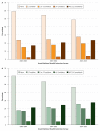Prevalence, Correlates, and Time Trends of Multiple Chronic Conditions Among Israeli Adults: Estimates From the Israeli National Health Interview Survey, 2014-2015
- PMID: 28796598
- PMCID: PMC5553352
- DOI: 10.5888/pcd14.170038
Prevalence, Correlates, and Time Trends of Multiple Chronic Conditions Among Israeli Adults: Estimates From the Israeli National Health Interview Survey, 2014-2015
Abstract
Introduction: Chronic diseases constitute a major public health challenge. The prevalence of multiple chronic conditions (MCC) has increased. The objective of our study was to describe the prevalence, correlates, and time trends of MCC in the Israeli population and among the nation's 2 main population groups (Jewish and Arab).
Methods: To describe the prevalence of correlates of MCC, we used data from the 2014-2015 Israeli National Health Interview Survey-III (INHIS-III). MCC was defined as having 2 or more of the following 10 self-reported physician-diagnosed chronic conditions: asthma, arthritis, cancer, diabetes, dyslipidemia, heart attack, hypertension, migraine, osteoporosis, or thyroid disease. For trend analysis, we used data from INHIS-I (2003-2004) and INHIS-II (2007-2010). Logistic regression was used for multivariate analysis. Estimates were weighted to the 2014 Israeli population. P for trend was calculated by using the Cochran-Armitage test for proportions.
Results: In 2014-2015, the prevalence of MCC was 27.3% (95% confidence interval, 25.7%-28.8%). In multivariate analysis, MCC was associated with older age, female sex, a monthly household income of USD$3,000 or less, current and past smoking, and overweight or obesity. After adjusting for age, sex, income, smoking status, and body mass index, differences in MCC between Jewish and Arab populations disappeared. Dyslipidemia and hypertension were the most prevalent dyad among both men and women. Dyslipidemia, hypertension, and diabetes were the most prevalent triad among both men and women. The age-adjusted prevalence of MCC increased by 6.7% between 2003-2004 and 2014-2015.
Conclusion: With the increase in the prevalence of MCC, a comprehensive approach is needed to reduce the burden of chronic conditions. Of special concern are the groups most prone to MCC.
Figures

Similar articles
-
Body weight dissatisfaction among Israeli Jewish and Arab women with normal or overweight-obese body mass index, Israeli INHIS-1, 2003-2004.Prev Chronic Dis. 2009 Apr;6(2):A51. Epub 2009 Mar 16. Prev Chronic Dis. 2009. PMID: 19288994 Free PMC article.
-
Prevalence and determinants of multiple chronic conditions (MCC) among young adults in Indian households: an analysis of NFHS-5.J Health Popul Nutr. 2024 Jun 4;43(1):77. doi: 10.1186/s41043-024-00560-0. J Health Popul Nutr. 2024. PMID: 38835054 Free PMC article.
-
Correlates of osteoporosis among Jewish and Arab women aged 45-74 in Israel: national women's health interview survey.J Gend Specif Med. 2003;6(1):17-23. J Gend Specif Med. 2003. PMID: 12661173
-
Prevalence of obesity in Israel.Obes Rev. 2005 May;6(2):115-6. doi: 10.1111/j.1467-789X.2005.00168.x. Obes Rev. 2005. PMID: 15836461 Review.
-
The prevalence and impact of migraine and severe headache in the United States: Updated age, sex, and socioeconomic-specific estimates from government health surveys.Headache. 2021 Jan;61(1):60-68. doi: 10.1111/head.14024. Epub 2020 Dec 21. Headache. 2021. PMID: 33349955
Cited by
-
Pain: its prevalence and correlates among the oldest old.Aging Clin Exp Res. 2024 Jan 20;36(1):2. doi: 10.1007/s40520-023-02653-y. Aging Clin Exp Res. 2024. PMID: 38252184 Free PMC article.
-
Household and area-level social determinants of multimorbidity: a systematic review.J Epidemiol Community Health. 2021 Mar;75(3):232-241. doi: 10.1136/jech-2020-214691. Epub 2020 Nov 6. J Epidemiol Community Health. 2021. PMID: 33158940 Free PMC article.
-
Age-Related Diseases and Clinical and Public Health Implications for the 85 Years Old and Over Population.Front Public Health. 2017 Dec 11;5:335. doi: 10.3389/fpubh.2017.00335. eCollection 2017. Front Public Health. 2017. PMID: 29312916 Free PMC article. Review.
-
Components of metabolic syndrome in patients with multiple myeloma and smoldering multiple myeloma.BMC Cancer. 2020 May 30;20(1):489. doi: 10.1186/s12885-020-06976-1. BMC Cancer. 2020. PMID: 32473631 Free PMC article.
-
Theoretical explanations for socioeconomic inequalities in multimorbidity: a scoping review.BMJ Open. 2022 Feb 23;12(2):e055264. doi: 10.1136/bmjopen-2021-055264. BMJ Open. 2022. PMID: 35197348 Free PMC article.
References
-
- Busse R, Blumel M, Scheller-Kreinsen D, Zentner A. Tackling chronic disease in Europe: strategies, interventions and challenges. Copenhagen (DK): European WHO Regional Office for Europe, Observatory on Health Systems and Policies; 2010.
-
- Mathers CD, Loncar D. Updated projections of global mortality and burden of disease, 2002–2030: data sources, methods and results. Geneva (CH): World Health Organization; 2005.
MeSH terms
LinkOut - more resources
Full Text Sources
Other Literature Sources
Medical
Miscellaneous

